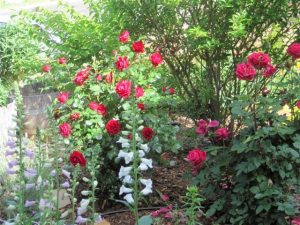We all know ‘that’ yard. We are drawn to one in every neighborhood. Plants seem to thrive in any season. Nothing “croaks” (a gardening term for refusing to live for one more minute, no matter what the gardener does); plants live as if in an arboretum. Daylilies and penstemons bloom in splendor in January, spring buds are starting, and weeds that should be sleeping are raising their little dandelion heads. This yard attracts wildlife year-round with foliage to hide in, left-over edible garden veggies, and sweet nectar flowers calling the hummingbirds.
Comparison with this yard is easy…same street, water from the same utility, same sunlight, same nursery. You scope out their fertilizer and soil amendments. You even sneak over to snap pictures of their plant tags. Your neighbor does not have alien hands with double green thumbs. What is happening here?
Where you are planted is important. (Ask the class troublemaker who wants to duck the teacher’s glare by sitting in the back of the classroom.) The same applies to plants in your yard. Every yard has several planting zones, some with better attributes than others. The right plant in the right place spells success.
Zones in your yard are either man-made or natural, creating small magical circles with environmental conditions that are distinctly different. These small magical circles, better known as microclimates, create excellent rooting positions for plant longevity.
Learning these different areas will make your yard healthier and resistant to weather. Many gardeners use the Sunset Garden Book or the USDA Hardiness Map to decide what to plant. Determining the particular microenvironment adds another successful layer to deciding what and where to plant.
Let’s start with the basic environment. For example, an open field has a uniform, consistent environment. Adding a home creates several microclimates. To the north of the building will be reduced light, increased shade, increased soil moisture and reduced temperatures. There may be increased winds.
To the south of the building will be increased heat, light, and higher evaporation from both plants and soil. Winds from the south are less frequent; drought is more prevalent. Comparing north to south sides, it is clear there are completely different growing conditions.
To find microclimates in your yard, compare elements of light, water, soil, wind, and temperature. Sunlight, or lack of it, creates extremes of shade or sun. Soil moisture may be too much or too little. Nearby streams, ponds, and lakes change daily temperatures by absorbing heat during the day and releasing it at night. Good soil type is like the discovery of gold; when it is good it is phenomenal. When it is bad, it takes work to improve it. Wind is a double-edged sword; a breeze may be cooling while gale forces dry out soil and plants. Extreme temperature changes, whether too hot or too cold, spell trouble.
Exposure to the elements may be limited or enhanced by cities, valleys, hilltops, paved surfaces, trees, raised beds, rocks, fences, and windbreaks. Discovery of optimum growing spots will make you, in addition to being an excellent gardener, an educated and savvy consumer. There may be plant “sacrificial lambs” while you learn your unique microenvironments, but, in the end, you’ll have a balanced garden of healthy plants thriving in their “right places.”
Julie Silva is a University of California Cooperative Extension Master Gardener of Tuolumne County.

